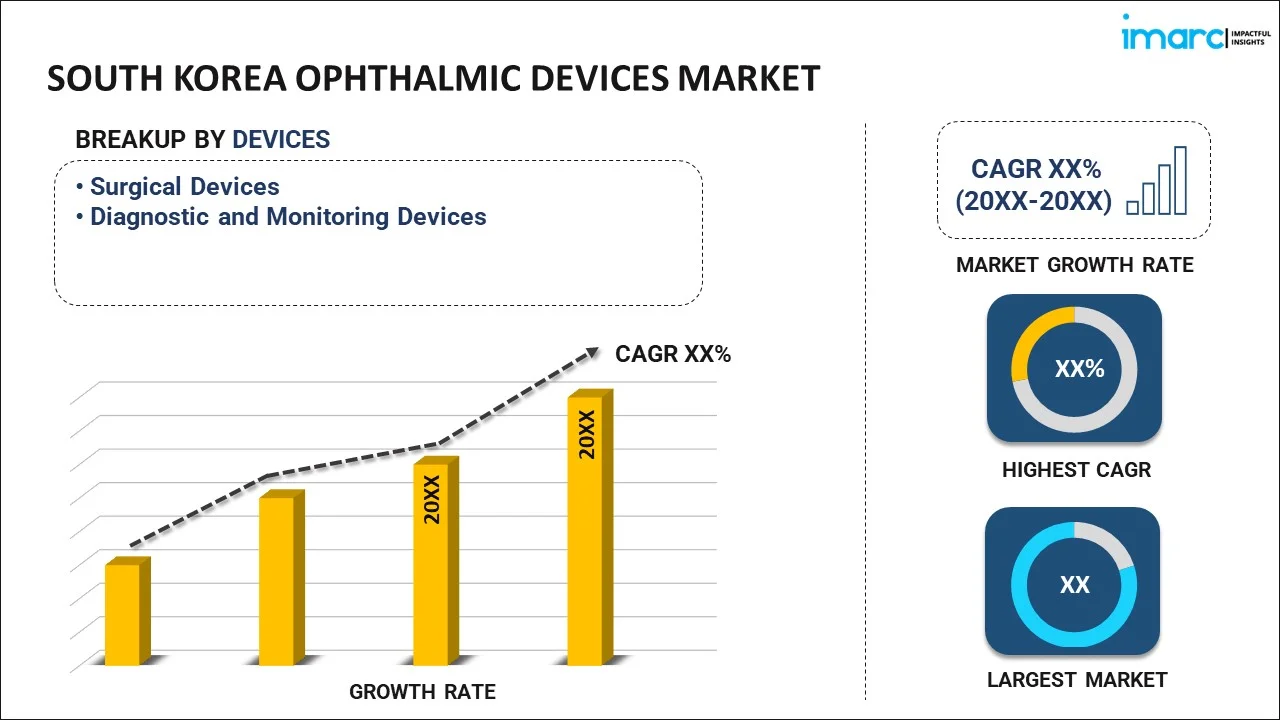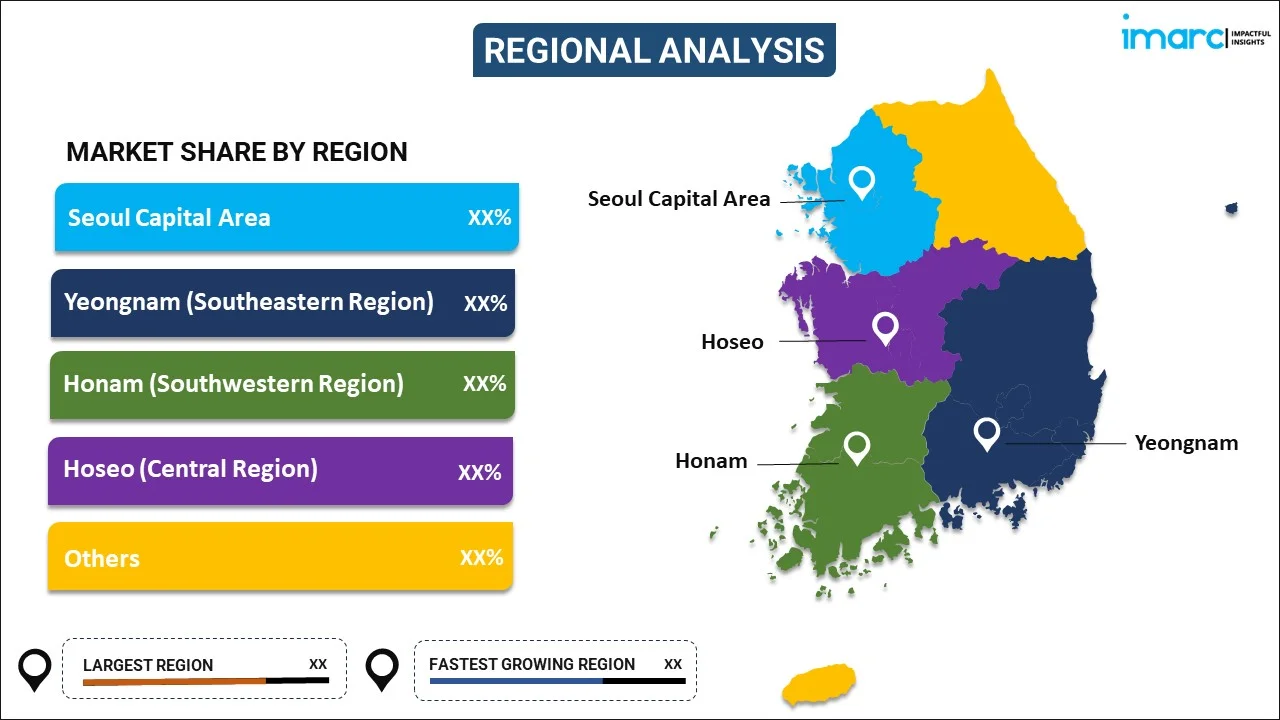
South Korea Ophthalmic Devices Market Report by Device (Surgical Devices, Diagnostic and Monitoring Devices), and Region 2025-2033
Market Overview:
South Korea ophthalmic devices market size reached USD 540.0 Million in 2024. Looking forward, IMARC Group expects the market to reach USD 740.0 Million by 2033, exhibiting a growth rate (CAGR) of 3.1% during 2025-2033. The growing prevalence of age-related eye disorders and conditions, increasing popularity of minimally invasive surgical (MIS) procedures and rising focus on personalized medicine and patient-centric approaches represent some of the key factors driving the market.
|
Report Attribute
|
Key Statistics
|
|---|---|
|
Base Year
|
2024 |
|
Forecast Years
|
2025-2033 |
|
Historical Years
|
2019-2024
|
| Market Size in 2024 | USD 540.0 Million |
| Market Forecast in 2033 | USD 740.0 Million |
| Market Growth Rate (2025-2033) | 3.1% |
Ophthalmic devices are utilized in the examination, diagnosis, and treatment of different eye conditions. These devices comprise ophthalmoscope, which are used to examine the interior structures of the eye. They also consist of tonometry devices that helps in measuring intraocular pressure, aiding in glaucoma diagnosis and management. They assist in determining refractive errors and used for prescribing eyeglasses and contact lenses. They ensure that treatment plans are accurate and effective, minimizing the risk of complications. They are designed with precision to meet the unique needs of ophthalmologists, optometrists, and other eye care professionals. They often incorporate cutting-edge technology, such as lasers, high-resolution imaging, and computer software, to enhance their diagnostic and treatment capabilities. They are created for mobility and convenience, allowing eye care professionals to conduct screenings and examinations in diverse settings. They are integrated with safety features to ensure the well-being of patients and healthcare providers. They are essential for advancing the understanding of eye diseases and improving treatment options through research. They are used to shine light into the eyes of patients and assess the refractive error by observing the reflection of light from the retina.
South Korea Ophthalmic Devices Market Trends:
At present, the increasing prevalence of age-related eye disorders and conditions, such as cataracts, glaucoma, and macular degeneration, represents one of the crucial factors impelling the growth of the market in South Korea. Besides this, the rising awareness about eye health and the importance of regular eye examinations is encouraging individuals to seek early diagnosis and treatment, increasing the need for diagnostic ophthalmic devices. Technological advancements and innovations in ophthalmic devices, particularly in the field of refractive surgery, are driving the adoption of state-of-the-art devices offering enhanced precision and safety gains momentum. In addition, the growing occurrence of diabetes among the masses, causing diabetic retinopathy, is offering a favorable market outlook in the country. Apart from this, the rising focus on personalized medicine and patient-centric approaches is catalyzing the demand for customization of ophthalmic devices to suit individual patient needs and preferences. Additionally, the increasing emphasis on sustainability and environmental concerns is leading to the development of eco-friendly ophthalmic devices and packaging. The rising popularity of minimally invasive surgical (MIS) procedures and preference for outpatient ophthalmic surgeries is driving the demand for advanced microsurgical devices in the country, as they enable quicker recovery and reduced post-operative complications. Furthermore, the emergence of combination devices, such as phacoemulsification systems that combine cataract surgery with intraocular lens implantation, is streamlining the surgical process and improving patient outcomes.
South Korea Ophthalmic Devices Market Segmentation:
IMARC Group provides an analysis of the key trends in each segment of the market, along with forecasts at the country level for 2025-2033. Our report has categorized the market based on devices.
Devices Insights:

- Surgical Devices
- Glaucoma Devices
- Intraocular Lenses
- Lasers
- Others
- Diagnostic and Monitoring Devices
- Autorefractors and Keratometers
- Ophthalmic Ultrasound Imaging Systems
- Ophthalmoscopes
- Optical Coherence Tomography Scanners
- Others
The report has provided a detailed breakup and analysis of the market based on the devices. This includes surgical devices (glaucoma devices, intraocular lenses, lasers, and others) and diagnostic and monitoring devices (autorefractors and keratometers, ophthalmic ultrasound imaging systems, ophthalmoscopes, optical coherence tomography scanners, and others).
Regional Insights:

- Seoul Capital Area
- Yeongnam (Southeastern Region)
- Honam (Southwestern Region)
- Hoseo (Central Region)
- Others
The report has also provided a comprehensive analysis of all the major regional markets, which include Seoul Capital Area, Yeongnam (Southeastern Region), Honam (Southwestern Region), Hoseo (Central Region), and Others.
Competitive Landscape:
The market research report has also provided a comprehensive analysis of the competitive landscape in the market. Competitive analysis such as market structure, key player positioning, top winning strategies, competitive dashboard, and company evaluation quadrant has been covered in the report. Also, detailed profiles of all major companies have been provided.
South Korea Ophthalmic Devices Market Report Coverage:
| Report Features | Details |
|---|---|
| Base Year of the Analysis | 2024 |
| Historical Period | 2019-2024 |
| Forecast Period | 2025-2033 |
| Units | Million USD |
| Scope of the Report | Exploration of Historical and Forecast Trends, Industry Catalysts and Challenges, Segment-Wise Historical and Predictive Market Assessment:
|
| Devices Covered |
|
| Regions Covered | Seoul Capital Area, Yeongnam (Southeastern Region), Honam (Southwestern Region), Hoseo (Central Region), Others |
| Customization Scope | 10% Free Customization |
| Post-Sale Analyst Support | 10-12 Weeks |
| Delivery Format | PDF and Excel through Email (We can also provide the editable version of the report in PPT/Word format on special request) |
Key Questions Answered in This Report:
- How has the South Korea ophthalmic devices market performed so far and how will it perform in the coming years?
- What has been the impact of COVID-19 on the South Korea ophthalmic devices market?
- What is the breakup of the South Korea ophthalmic devices market on the basis of devices?
- What are the various stages in the value chain of the South Korea ophthalmic devices market?
- What are the key driving factors and challenges in the South Korea ophthalmic devices?
- What is the structure of the South Korea ophthalmic devices market and who are the key players?
- What is the degree of competition in the South Korea ophthalmic devices market?
Key Benefits for Stakeholders:
- IMARC’s industry report offers a comprehensive quantitative analysis of various market segments, historical and current market trends, market forecasts, and dynamics of the South Korea ophthalmic devices market from 2019-2033.
- The research report provides the latest information on the market drivers, challenges, and opportunities in the South Korea ophthalmic devices market.
- Porter's five forces analysis assist stakeholders in assessing the impact of new entrants, competitive rivalry, supplier power, buyer power, and the threat of substitution. It helps stakeholders to analyze the level of competition within the South Korea ophthalmic devices industry and its attractiveness.
- Competitive landscape allows stakeholders to understand their competitive environment and provides an insight into the current positions of key players in the market.
Need more help?
- Speak to our experienced analysts for insights on the current market scenarios.
- Include additional segments and countries to customize the report as per your requirement.
- Gain an unparalleled competitive advantage in your domain by understanding how to utilize the report and positively impacting your operations and revenue.
- For further assistance, please connect with our analysts.
 Inquire Before Buying
Inquire Before Buying
 Speak to an Analyst
Speak to an Analyst
 Request Brochure
Request Brochure
 Request Customization
Request Customization




.webp)




.webp)












